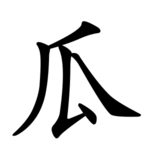Radical 97 or radical melon (瓜部) meaning "melon" is one of the 23 Kangxi radicals (214 radicals in total) composed of 5 strokes (6 strokes in Japanese).
| 瓜 | ||
|---|---|---|
| ||
| 瓜 (U+74DC) "melon" | ||
| Pronunciations | ||
| Pinyin: | guā | |
| Bopomofo: | ㄍㄨㄚ | |
| Wade–Giles: | kua1 | |
| Cantonese Yale: | gwā | |
| Jyutping: | gwaa1 | |
| Japanese Kana: | カ ka (on'yomi) うり uri (kun'yomi) | |
| Sino-Korean: | 과 gwa | |
| Names | ||
| Chinese name(s): | 瓜字旁 guāzìpáng | |
| Japanese name(s): | 瓜/うり uri | |
| Hangul: | 오이 oi | |
| Stroke order animation | ||
 | ||
In the Kangxi Dictionary, there are 55 characters (out of 49,030) to be found under this radical.
瓜 is also the 113th indexing component in the Table of Indexing Chinese Character Components predominantly adopted by Simplified Chinese dictionaries published in mainland China.
Evolution
edit-
Large seal script character
-
Small seal script character
Derived characters
edit| Strokes | Characters |
|---|---|
| +0 | 瓜 |
| +3 | 瓝 |
| +5 | 瓞 瓟 |
| +6 | 瓠 |
| +8 | 瓡 |
| +11 | 瓢 |
| +14 | 瓣 |
| +17 | 瓤 |
| +19 | 瓥 |
Variant forms
editThere is a design nuance between the form of 瓜 in modern Japanese and in other languages. Traditionally, the character consists of five strokes. In Japanese kanji simplification, however, the third stroke (i.e. a vertical-horizontal turning stroke) was broken into two strokes, and 瓜 became a six-stroke radical character. This change also applies to hyōgai kanji.
| Chinese (Mainland China) |
Chinese (Taiwan) |
Modern Japanese |
|---|---|---|
| 瓜 | 瓜 | 瓜 |
| 瓞 | 瓞 | 瓞 |
Literature
edit- Fazzioli, Edoardo (1987). Chinese calligraphy : from pictograph to ideogram : the history of 214 essential Chinese/Japanese characters. calligraphy by Rebecca Hon Ko. New York: Abbeville Press. ISBN 0-89659-774-1.
- Lunde, Ken (Jan 5, 2009). "Appendix J: Japanese Character Sets" (PDF). CJKV Information Processing: Chinese, Japanese, Korean & Vietnamese Computing (Second ed.). Sebastopol, Calif.: O'Reilly Media. ISBN 978-0-596-51447-1.